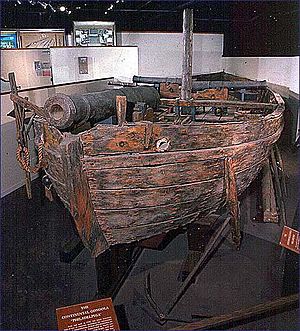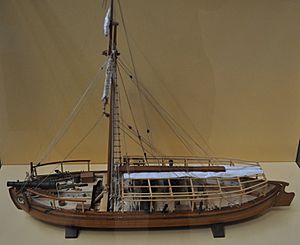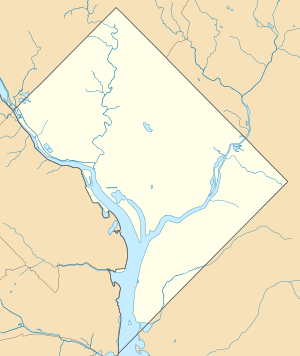USS Philadelphia (1776) facts for kids

Philadelphia on display at the National Museum of American History
|
|
Quick facts for kids History |
|
|---|---|
| Name | Philadelphia |
| Namesake | City of Philadelphia |
| Builder | Hermanus Schuyler |
| Laid down | July 1776 |
| Launched | August 1776 |
| Completed | August 1776 |
| Fate |
|
| Status | On public display |
| General characteristics | |
| Type | Gundalow |
| Displacement | 29 long tons (29 t) |
| Length | 53 ft (16 m) |
| Beam | 15 ft (4.6 m) |
| Draft | 2 ft (0.61 m) |
| Depth | 4 ft (1.2 m) |
| Complement | 45 |
| Armament |
|
|
Philadelphia (Gundalow)
|
|

Model of Philadelphia as built
|
|
| Location | 14th St. and Constitution Ave., NW Washington, D.C. |
| Built | 1776 |
| Architect | Hermanus Schuyler |
| NRHP reference No. | 66000852 |
| Significant dates | |
| Added to NRHP | 15 October 1966 |
| Designated NHL | 20 January 1961 |
USS Philadelphia was a special type of gunboat called a gundalow. It was built quickly in 1776 for the American Revolutionary War. Its crew were soldiers from the American army.
The Philadelphia was part of a fleet led by General Benedict Arnold. This fleet fought against the British Royal Navy in the Battle of Valcour Island on Lake Champlain. The Philadelphia was sunk during this battle on October 11, 1776.
Many years later, in 1935, a history fan named Lorenzo Hagglund found the ship. It was standing upright at the bottom of Lake Champlain. He brought it up from the water. In 1961, the Philadelphia was given to the Smithsonian Institution.
Today, the Philadelphia and other items found with it are on display. You can see them at the National Museum of American History in Washington, D.C.. The ship is also listed as a special historical place.
Contents
Why the Philadelphia Was Built
The American Revolutionary War started in April 1775. Later that year, American soldiers tried to invade Quebec, which was controlled by the British. This invasion failed badly in December 1775.
In the spring of 1776, many British and German soldiers arrived in Quebec. General Guy Carleton pushed the American army out of Quebec. The Americans went back to Fort Ticonderoga.
General Carleton then planned to attack the Americans. He wanted to reach the Hudson River. If the British controlled the Hudson River, they could connect their forces in Quebec with those in New York City. This would cut off the New England colonies from the southern ones.
At this time, there were only a few small American ships on Lake Champlain. These ships were not enough to stop the British. So, both sides started building more ships.
Building the Fleets
As the Americans left Quebec, they made sure to destroy or take all ships on Lake Champlain. This stopped the British from using them right away. The Americans also burned a sawmill and a fort.
Both the British and Americans began building new fleets. The British built their ships at Saint-Jean. The Americans built theirs at Skenesborough, which is now Whitehall, New York. The British had planned ahead and brought parts for ships from Europe. This helped them build a much stronger fleet.
The British fleet had 25 armed ships. They had more than 80 guns. The American fleet had 15 ships with 74 smaller guns. The British had a lot more firepower.
Hermanus Schuyler led the American shipbuilding in Skenesborough. General Benedict Arnold, who knew a lot about ships, also helped. He became very involved in the effort.
How the Philadelphia Was Made
The Philadelphia was one of eight gundalows built at Skenesborough. Its construction started in July 1776. It was ready to launch by mid-August.
The ship was mostly made of oak. It was about 53 ft 2 in (16.21 m) long and 15 ft 2 in (4.62 m) wide. It had one tall mast with a large sail. The Philadelphia carried three cannons. One 12-pounder (5.4 kg) cannon faced forward. Two 9 pounders (4.1 kg) cannons faced the sides. It also had spots for up to eight smaller swivel guns.
The ship was designed to carry about 29 long tons (32.5 short tons; 29.5 t) of weight. Near the end of its building, General Arnold wanted to add a mortar (a type of cannon) to the back deck. But this mortar exploded during a test. So, it was removed. Rocks were likely used to balance the boat instead.
To protect the crew, the boat had a canvas cover at the back. Bundles of sticks, called fascines, were probably tied to its sides. These would help stop musket fire.
The Philadelphia's Battle
Captain Benjamin Rue was in charge of the Philadelphia. In late August, General Arnold gathered his fleet. They sailed around the northern part of Lake Champlain. On September 23, Arnold placed his ships in Valcour Bay. This was a good spot to wait for the British fleet.
The two forces met on October 11 in the Battle of Valcour Island. The Philadelphia was part of Arnold's battle line. Early in the six-hour fight, another American ship, the Royal Savage, got stuck and was burned.
As evening came, British cannons hit the Philadelphia. A large 24-pound (10.9 kg) cannonball made a hole in the ship. It soon sank. Darkness ended the battle. Arnold was able to sneak away with his remaining ships during the night. Many of his other ships were later burned, sunk, or captured as the British chased them.
Later tests with a replica ship, Philadelphia II, showed that these boats were not easy to steer. Old reports say the gundalows would skip across the lake in strong winds. They needed safe places to hide when the wind was high.
Finding and Saving the Ship
In the 1930s, Lorenzo Hagglund, a World War I veteran and history lover, started looking for ships from the battle. In 1932, he found parts of the Royal Savage. He successfully brought it up in 1935.
That same year, Hagglund found the Philadelphia. It was sitting upright on the bottom of Lake Champlain. He raised it from the water. Along with the ship and its guns, hundreds of other items were found. These included cannonballs, cooking tools, buttons, and even human bones.
The Philadelphia was shown in different places for many years. Lorenzo Hagglund kept looking for other ships from Arnold's fleet. He found another gunboat in 1952. But there was no money to build a place to keep it. That ship's remains were later ruined.
Because of this, Hagglund asked the Smithsonian Institution to take care of the Philadelphia. In 1961, he gave the ship and all its artifacts to them. The ship had actually been damaged more while it was above water than when it was at the bottom of the lake.
Today, the Philadelphia and its items are part of the permanent collection. You can see them at the National Museum of American History in Washington, D.C.. It is a very important historical landmark. Even now, the wood and iron parts of the ship need constant care to stop them from getting worse.
In 1997, another perfectly preserved shipwreck was found. Two years later, it was confirmed to be the gundalow Spitfire.
|



